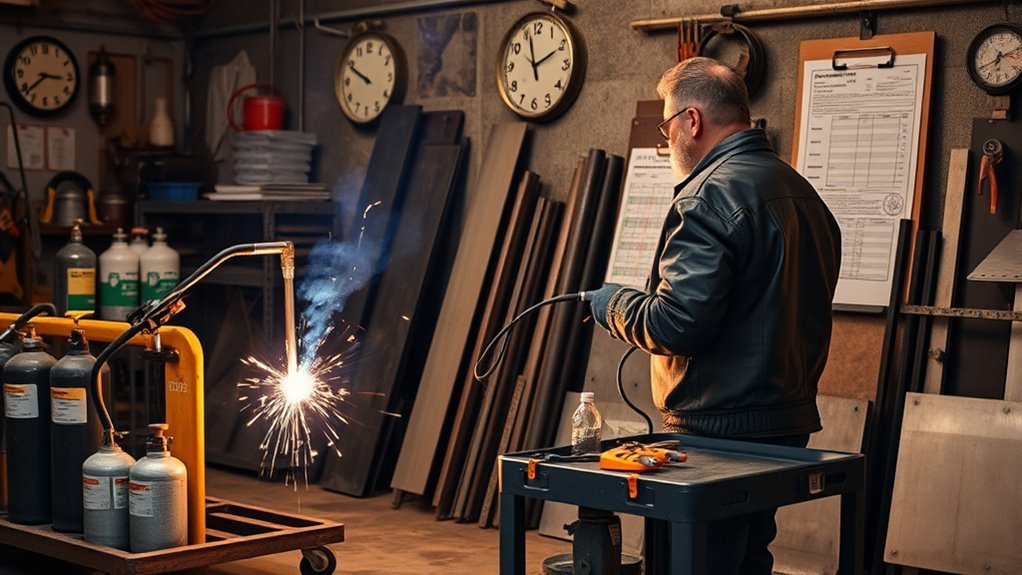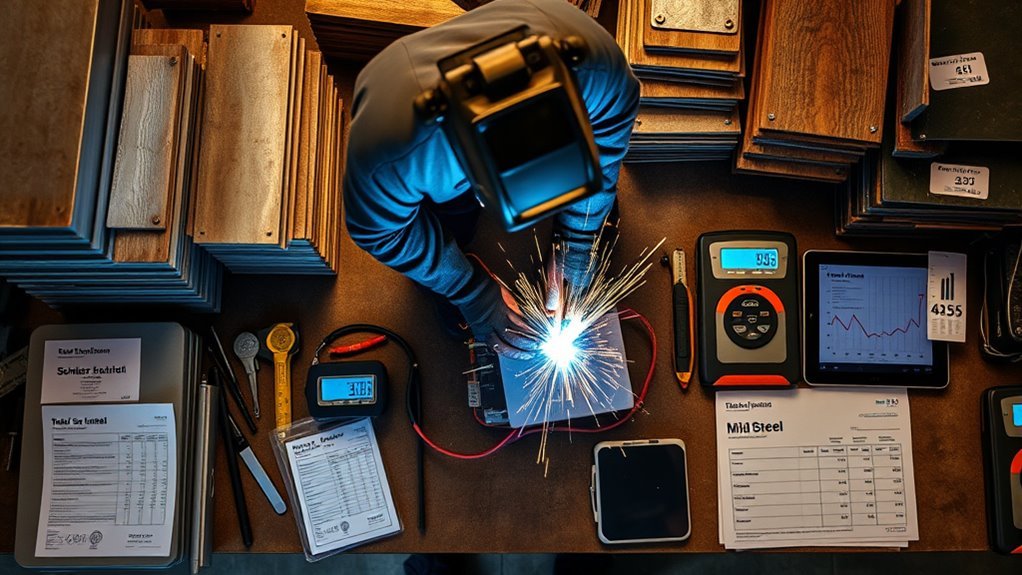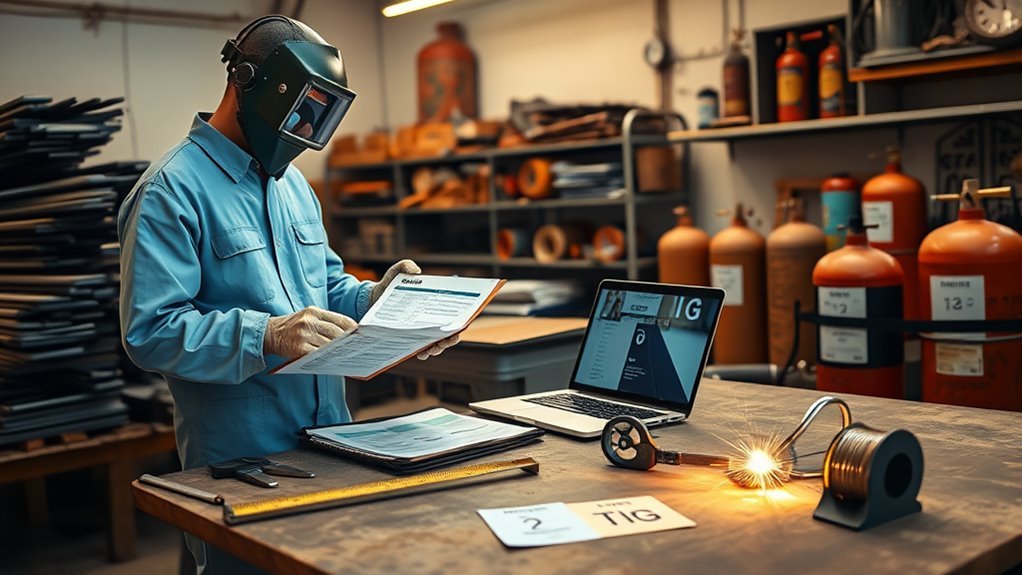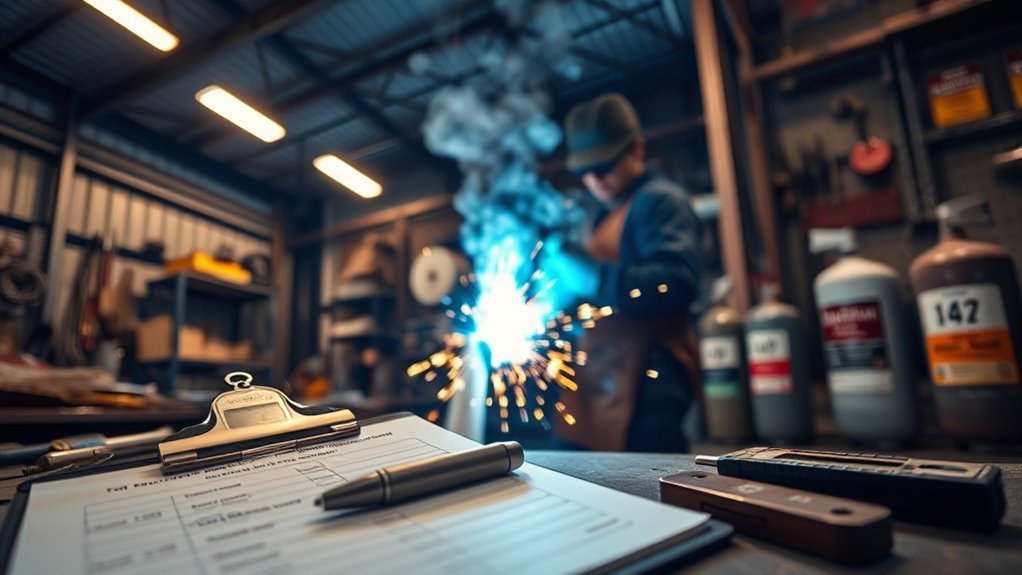You’ll typically pay $50–$125 per hour for a qualified welder, with mobile work or specialists pushing effective rates to $75–$200+ per hour due to minimum charges and travel. Costs depend on technique (TIG costs more than MIG), material (aluminum and stainless cost 1.5–2× steel), consumables, and project complexity. Provide drawings and material lists for accurate bids, verify certifications, and get multiple estimates — keep going and you’ll find detailed cost breakdowns and hiring tips.
Welder Hourly Rates and Minimum Charges

Hourly rates for welding generally run $50–$65 nationally, though specialized work can reach $200/hr, and you’ll often face minimum charges that raise the effective hourly cost.
Expect welding rates around $50–$65/hr nationally; specialized jobs can climb to $200/hr and often include minimum charges.
You should expect welding service pricing to include explicit minimums: mobile services commonly start at $75 for the first hour, MIG jobs may carry a $40 minimum, and TIG often has a $75 minimum due to consumables.
Some shops apply a flat $60 startup fee and then bill $60/hr thereafter, so check invoices for those line items.
You’ll rely on welder experience when evaluating estimates; an experienced operator gives more accurate time and material forecasts and reduces surprise charges.
Record quoted minimums and fees before authorizing work.
Factors That Affect Welding Costs

Because multiple variables determine a final quote, you should evaluate skill level, materials, complexity, and consumables when estimating welding costs.
You’ll factor the welder’s hourly rate, typically $50–$125, where experience and certifications raise labor costs and geographic location impact local pricing.
Material choice alters expense: steel is least costly, while aluminum or stainless steel often run 1.5–2× higher.
Welding project complexity increases labor time and may require specialized fixtures or procedures, driving rates upward.
Include consumables—electrodes, filler rod, shielding gas—and account for market-driven material price volatility that can spike costs during downturns.
Methodically itemize labor hours, material quantities, and consumable usage to produce an accurate, defensible estimate.
Types of Welding and How They Influence Price

Having itemized labor, materials, and consumables in your estimate, now compare how specific welding processes change those line items and total cost.
You’ll find welding techniques differ in labor rate, consumable type, and setup time. Stick welding (SMAW) minimizes equipment and consumables, lowering material overhead but raising labor on complex joints.
MIG (GMAW) increases speed, reducing labor minutes for straightforward work; gas requirements add moderate consumable costs.
TIG (GTAW) demands higher skill and slower deposition, raising hourly rates and precision-related rejects; inert gas and filler alloys boost material expense.
FCAW suits heavy or dirty joints but can increase consumable consumption and cleanup labor.
For unique materials or intricate geometry, expect specialist hourly rates up to about $200 due to required material compatibility and technique control.
Material and Metal Cost Breakdown

When you break down material costs for a welding job, account for base metals, consumables, and ancillary supplies separately so you can quantify their individual impact on the estimate.
You’ll itemize welding material types and consumables to support accurate welding project budgeting. Use unit pricing and typical example costs to model estimates.
- Base metals: steel is cheapest; aluminum and stainless run 1.5–2× steel.
- Stock lengths: a 25-ft 2×6 14-gauge stick is $44–$50, but can spike to $125 under market stress.
- Consumables: wire (30 lb roll ≈ $40), rods, shielding gas; include replacement frequency.
- Ancillaries: sanding paper/grinding wheels (~$64/week), tips, clamps — treat as recurring line items.
Tips for Hiring a Welder and Getting Accurate Estimates

After you’ve itemized metals, consumables and ancillaries, focus on getting reliable bids: give the welder detailed drawings or photos, specify materials and tolerances, and list any access or finish requirements so they can size labor and material needs accurately.
For welding project preparation, assemble dimensioned sketches, photos of site access, and a parts/materials list to remove ambiguity. Request a free estimate from multiple providers and compare line-item costs: hourly rates, anticipated labor hours, material allowances and contingency for additional materials.
When choosing qualified welders, verify certifications, specific process experience and representative work photos; check customer reviews and references. Use this methodical approach to minimize scope creep and obtain accurate, comparable estimates for decision-making.
Frequently Asked Questions
Do Mobile Welders Carry Liability Insurance and What Does It Cover?
Yes — you should verify insurance coverage: mobile welder responsibilities typically include general liability and sometimes commercial auto and workers’ comp; these policies cover property damage, bodily injury, and vehicular incidents arising from on-site welding operations.
Can Welding Jobs Be Scheduled for Evenings or Weekends?
Want work outside business hours? You can schedule evening scheduling and weekend availability; we’ll confirm technician, tools, and safety protocols, estimate extra labor or travel fees, and set precise start/end times to minimize disruption.
Do Welders Provide Written Warranties on Their Workmanship?
Yes — you’ll often get written warranty terms specifying workmanship guarantees, duration, and coverage. Read exclusions, testing criteria, and repair procedures carefully, and request signed documentation outlining remediation steps, inspection standards, and responsible parties.
Are Permits Required for Structural Welding Work at My Property?
Yes — you’ll typically need permits for structural welding; follow local welding regulations and the permit process, submit engineered plans, inspections, and qualified welder certifications, and coordinate with building authorities to guarantee code compliance and documented approvals.
What Safety Precautions Should I Take Before the Welder Arrives?
Like clockwork, clear the area: you’ll remove combustibles, mark hazards, and cordon the zone. Check safety gear, verify ventilation, secure permits, provide lighting, and guarantee a stable workspace preparation so the welder can start safely.
Conclusion
You’ve seen the rates, variables and materials — now make choices with the clarity of a machinist’s gauge. Weigh hourly charges, minimums and metal prices, account for joint complexity and travel, and pick the welding process that matches strength and finish requirements. Ask for itemized estimates, verify certifications, and plan for prep and cleanup. With methodical comparison and clear specs, you’ll avoid surprises and forge a reliable, cost-effective outcome.


